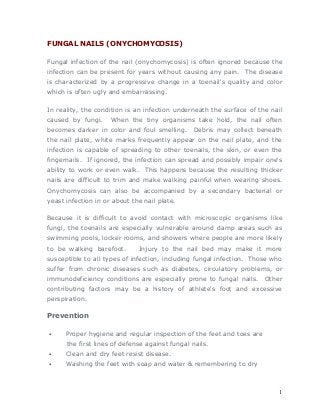
Fungal nails
- 1. FUNGAL NAILS (ONYCHOMYCOSIS) Fungal infection of the nail (onychomycosis) is often ignored because the infection can be present for years without causing any pain. The disease is characterized by a progressive change in a toenail's quality and color which is often ugly and embarrassing. In reality, the condition is an infection underneath the surface of the nail caused by fungi. When the tiny organisms take hold, the nail often becomes darker in color and foul smelling. Debris may collect beneath the nail plate, white marks frequently appear on the nail plate, and the infection is capable of spreading to other toenails, the skin, or even the fingernails. If ignored, the infection can spread and possibly impair one's ability to work or even walk. This happens because the resulting thicker nails are difficult to trim and make walking painful when wearing shoes. Onychomycosis can also be accompanied by a secondary bacterial or yeast infection in or about the nail plate. Because it is difficult to avoid contact with microscopic organisms like fungi, the toenails are especially vulnerable around damp areas such as swimming pools, locker rooms, and showers where people are more likely to be walking barefoot. Injury to the nail bed may make it more susceptible to all types of infection, including fungal infection. Those who suffer from chronic diseases such as diabetes, circulatory problems, or immunodeficiency conditions are especially prone to fungal nails. Other contributing factors may be a history of athlete's foot and excessive perspiration. Prevention • Proper hygiene and regular inspection of the feet and toes are the first lines of defense against fungal nails. • Clean and dry feet resist disease. • Washing the feet with soap and water & remembering to dry 1
- 2. • thoroughly is the best way to prevent an infection. • Shower shoes should be worn when possible in public areas. • Shoes, socks, or hosiery should be changed more than once daily. • Toenails should be clipped in a manner that the nail does not extend beyond the tip of the toe. • Wear shoes that fit well and are made of materials that breathe. • Avoid wearing excessively tight hosiery which encourages moisture. • Socks made of synthetic fiber tend to "wick" away moisture faster than cotton or wool socks. • Disinfect instruments used to cut nails. • Disinfect home pedicure tools. • Don't apply polish to nails suspected of infection—those that are red, discolored, or swollen, for example. Treatment of Fungal Nails Treatments may vary depending on the nature and severity of the infection. A daily routine of cleansing over a period of many months may temporarily suppress mild infections. White markings that appear on the surface of the nail can be filed off. This is followed by the application of an over-the-counter liquid antifungal agent. However, even the best over- the-counter treatments may not prevent a fungal infection from coming back. A podiatric physician can detect a fungal infection early, culture the nail, determine the cause, and form a suitable treatment plan. This may include prescribing topical and/or oral medications and debridement (removal of diseased nail matter and debris) of an infected nail. Oral antifungals approved by the Food and Drug Administration may be the most effective treatment. They offer a shorter treatment regimen of approximately three months and improved effectiveness. However, many of these medications are metabolized through and stress the liver. Your 2
- 3. prescribing podiatric physician will obtain a series of blood work to closely monitor the health of your liver while you are on the medication. In some cases, surgical treatment may be required. Temporary removal of the infected nail can be performed to permit direct application of a topical antifungal. Permanent removal of a chronically painful fungal nail (that has not responded to any other treatment) permits the fungal infection to be cured and prevents the return of a deformed nail. Trying to solve the infection without the qualified help of a podiatric physician can lead to more problems. With new technical advances in combination with simple preventive measures, the treatment of this lightly regarded health problem can often be successful. © 2010 American Podiatric Medical Association, Inc.. 3
- 4. Dr. Nigro Foot and Ankle Care Centers The Best Available Care; Trusted by Doctors and Preferred by Patients http://www.PittsburghFootAndAnkle.com Call any of our Four Office Locations for an Appointment Main Office (Vandergrift) 127 Columbia Ave, Vandergrift, PA 15690 Phone: (724) 567-7520, Fax: (724) 568-2169 Glenshaw Office 922 Garden Place, Glenshaw, PA 15116 Phone: (412) 486-5100, Fax: (412) 486-5122 Natrona Heights Office 1601 Union Ave Suite B, Natrona Heights, PA 15065 Phone: (724) 226-0544, Fax: (724) 226-2172 Cabot Office Concordia Professional Building 1134 Marwood Road, Cabot, PA 16023 Phone: (724) 226-0544, Fax: (724) 226-2172
